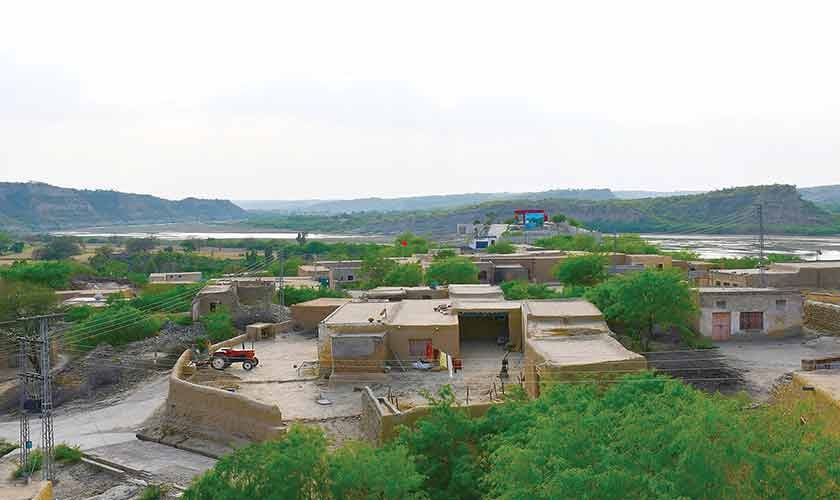Markhal is a remote village in Chakwals Talagang tehsil, located on the left bank of the Soan River, approximately 42 kilometres northwest of Talagang town. From the surrounding hills, one has a beautiful view of the village and the Soan River. Its picturesque setting between the Soan River and the Qavala Nullah makes Markhal one of the most magnificent villages in the Talagang region. Mud-plastered houses, juxtaposed against the hills and the Soan River, turn this village into a marvel of Talagang.
Despite its beauty, the village is marred by a lack of basic healthcare facilities and a higher secondary school for girls. The village is also noted for its shrines, historic mosque, and tombstones.
### Visit to Markhal Village
I visited Markhal village with my friend, Tariq Mehmood Malik, a historian and author familiar with the history and heritage of every village in the area, many of which face significant economic challenges. In Markhal, we interviewed many residents about the Jamia Masjid, shrines, and tombstones.
During the interviews with community members, I learned that the Jamia Masjid Noorani is the oldest mosque in the village. It was probably built when the village was founded. Originally a small mosque, it later underwent renovations and expansion. According to Qari Umer Bilal Awan Mairvi, the current pesh-imam of the mosque, the mosque was rebuilt around 1930.
Stone brought from the nearby Markhal hill was dressed and used in the mosque. The place from where the stone was extracted was called Kali Watey Wali Jagah, and the villagers themselves transported the stone. Two eminent masons of Markhal, Mian Muhammad and Baba Gul Muhammad, constructed the mosque.
### Architecture and Craftsmanship
Stone was the main building material in pre-Partition buildings in most villages in Talagang tehsil. The mosques, mansions, and temples in the area were all built of stone, which was readily available from tributaries of the Soan River. Although the mosque has been rebuilt relatively recently, some of its original features remain.
The western boundary wall, part of the original construction, has been built using both small and large dressed and undressed stone slabs by Mistri Mian Muhammad and Mistri Baba Gul Muhammad. In addition to the western boundary wall, the structure retains one of its original wooden doors, decorated with geometric and floral patterns. Both the lower and upper sections of the door feature geometric patterns, with bell-shaped designs on the upper part.
These patterns are also found in carved wooden doors of several old havelis and mosques in the Pothohar region. Similar bell-shaped patterns are observed in the stone-built mosques of Chakwal, particularly in two mosques located in Vahali and Haral villages of Choa Saidan Shah tehsil. Both were constructed by Mistri Sher Muhammad, the most celebrated mason in Chakwal district, who hailed from Takiya Shah Murad village near Khanpur and inspired many masons in both Jhelum and Chakwal.
Jamia Masjid Noorani once had a wooden ceiling that was removed during the mosque’s reconstruction. Mosques in Talagang, constructed in the 19th and 20th centuries, featured certain distinctive elements, including wooden doors and ceilings. Some of the most impressive wooden ceilings can still be found in the Shahi Jamia Masjid of Khichi village, Jamia Masjid Farooq-i-Azam of Singwala village, and the Jamia Masjid of Jasial village.
### Notable Nearby Mosques
Khichi (or Khichian) is a historic settlement in Talagang tehsil, located about 27 kilometres from Talagang city on the Talagang-Khushsab Road. The village is famous for its Mughal-era mosque, built in the second quarter of the 18th century. This mosque has remarkable inscriptions, wooden doors, pillars, and ceilings.
The main prayer hall of the mosque is covered with a wooden roof resting on decorative pillars carrying floral designs. Four decorative pillars are attached to the eastern wall. It appears there were an equal number on the western wall, as suggested by volutes now placed on the wall—possibly concealed in the thickness of the wall. Each pillar has a single volute with floral designs.
A similar wooden ceiling and pillared hall can be seen in the Jamia Masjid of Chawli in Chakwal and the Jamia Masjid in Maria Sharif in Pindi Gheb.
Another notable village, Jasial in Talagang tehsil, is known for its magnificent Jamia Masjid with a remarkable painted wooden ceiling showcasing the mastery of Talagang’s craftsmen.
I have also seen an impressive wooden ceiling in Jamia Masjid Farooq-i-Azam in Singwala village, notable for its paintings and woodwork. This mosque was built by Mistri Sirajuddin, the famous mason of Pachnand village in Lawa tehsil.
Such wooden ceilings were common in many stone-built mosques constructed along the Soan River and its tributaries. Unfortunately, the majority of these mosques have been renovated or rebuilt, with most wooden ceilings removed during these processes.
### Tombstones and Shrines in Markhal
The masons of Markhal were also skilled stone carvers. Apart from the mosque, the tombstones in Markhal cemetery testify to their workmanship. The old village cemetery is located near the Government Girls Elementary School and contains several tombstones marked with two grave markers on the northern and southern sides.
These tombstones feature various floral and geometric designs, with some of the most attractive being representations of the musalla (prayer rug) and the lota (ewer). A few women’s graves have carved combs. Similar decorative gravestones are found in many villages across Talagang tehsil.
According to Sher Zaman Awan of Markhal village, most of these tombstones were engraved by Mistri Mian Muhammad, Mistri Baba Gul Muhammad, and Mistri Nur Akhmat.
There are four shrines in the village, two of which are located in the cemetery near the school. The most popular shrine belongs to Baba Pir Budhey Shah Hamdani.
### Baba Pir Budhey Shah Hamdani and Urs Festival
According to Qari Umer Bilal Awan Mairvi, Baba Pir Budhey Shah Hamdani came from Chakrala village in Mianwali around 1925. This information was passed down from Qari Umer’s father, Fazl Ilahi, who was 97 years old at his death in 2018. Fazl Ilahi was knowledgeable about the village’s history and shrines, including those related to Hindus and Sikhs.
Baba Pir Budhey Shah Hamdani lived in the village for only four years before his death. Although his descendants wished to bury him in Chakrala, the residents of Markhal wanted him to be buried there. Upon their request, his descendants agreed, and a beautiful tomb was built over his grave.
His urs is held every March, featuring qawwali performances at the shrine alongside various traditional sports and games, including bull races and kabaddi.
### Kabaddi Legacy
From interviews with community members, I learned that the village has produced two notable kabaddi players: Baba Sanwal Khan and Malik Jehangir Khan. Baba Sanwal Khan was a renowned kabaddi player and a devoted follower of Maira Sharif darbar in Pindi Gheb.
Maira Sharif is famous for the shrine of Khwaja Ahmad, a deputy of Pir Pathan (died 1850). Many residents of Markhal have followed Khwaja Ahmad Mairvi. Another notable disciple of Hazrat Sani (died 1931), the first sajjada nashin of the Maira Sharif darbar, was Haji Suba Khan.
To this day, many followers of the Maira Sharif Darbar identify with the suffix “Mairvi” as an indication of their Sufi affiliation. Maulvi Ahmed Mairvi was a disciple of Khawaja Faqir Muhammad Abdullah Mairvi (died 1975). Furthermore, Qari Umer Bilal Awan Mairvi is a follower of Sahibzada Farooq Ahmed, the current sajjada nashin of the darbar of Khawaja Ahmad Mairvi.
### Other Shrines in Markhal
Another shrine in the cemetery is dedicated to Shah Chan Gilani. The Awan tribe forms the majority of the population in the village, with a few households of Gilani Sadat residing in Markhal.
The grave of Baba Pir Charag Shah Gilani is located in an enclosure that also contains the graves of his ancestors and descendants.
—
Markhal’s rich architectural heritage, shrines, and cultural traditions make it a significant and fascinating village in the Talagang region. However, addressing its economic development, particularly in healthcare and education, remains vital for the community’s future.
https://www.thenews.com.pk/tns/detail/1350007-magnificent-markhal-village-of-talagang


